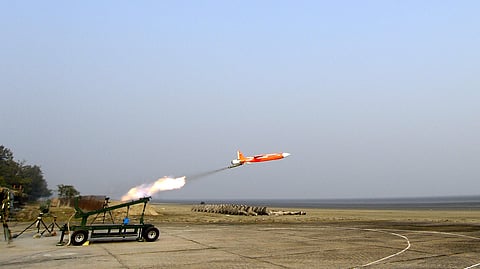

BHUBANESWAR: The Defence Research and Development Organisation (DRDO) successfully conducted the flight test of indigenously developed High-speed Expendable Aerial Target (HEAT) Abhyas from Integrated Test Range (ITR) off Odisha coast on Thursday.
Defence sources said the unmanned aerial vehicle demonstrated high subsonic speed trajectory at a very low altitude with high endurance during the flight trial.
Two boosters provided initial acceleration during launch and a small turbo jet engine used to sustain high subsonic speed with long endurance was validated.
The indigenous data link designed by Bengaluru based industry partner was tested successfully during the flight.
The performance of the system during the entire flight duration has been confirmed from the data captured by various range instruments deployed.
Bengaluru based Aeronautical Development Establishment (ADE) along with other DRDO laboratories has developed the pilotless target system to meet the requirement of aerial targets of Indian Armed Forces.
The aircraft is controlled from a ground based controller and an indigenously developed Micro Electro Mechanical System (MEMS) based inertial navigation system along with the flight control computer, which helps it to follow the pre-designated path in a fully autonomous mode.
Abhyas can be launched from a mobile launcher using two 68-mm boosters that are separated after the initial burnout. A small gas turbine powers the aerial vehicle to fly during the cruise phase. It is expected to supplement pilotless target aircraft Lakshya-I and Lakshya-II, already inducted in the armed forces.
Having a length of 2,385 mm and diameter of 180 mm, the drone weighs around 75 kg.
With a speed of Mach 0.5, it can attain an altitude of more than 5 km. The check out of the air vehicle is done using laptop-based ground control station.
Secretary Department of Defence (R&D) and DRDO Chairman Dr G Satheesh Reddy complimented scientists of the laboratories, their team members and associated industry partners for the successful development efforts.
Defence Minister Rajnath Singh congratulated DRDO said the successful test is noteworthy testimony of synergy between scientists and industry.